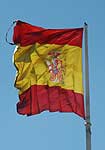SPAIN TRIP Aug 2-16 2006
Additional pictures:
Madrid to Ronda
Granada to Morella
Barcelona to Madrid

Last year Ryan, who has a birthday two days after mine, and I agreed to give each other time rather than gifts. We started talking about a trip together for a few weeks in the summer of 2006; the idea was that we’d choose a country (likely in Europe) that neither of us had yet visited. Despite his up-coming wedding in June 2006, Lauren, wanting to have his rightful part in this plan, opted in on the deal.
The three of us have a long history of traveling together
- a practice that that began when the two of them were young boys. These trips created a multitude
of great memories for all of us. So, Lauren’s coming along on this venture meant that it
would be the three of us “on the road again.”
The chosen destination was Spain; so, on August 2, I flew from Victoria through Vancouver and
met them in Toronto from whence we flew through Heathrow and into Madrid. After 24 hours of travel,
we quickly settled into Hostal Acapulco
– a simple, clean, safe 4th floor hotel in a great location just off of Gran Via half way
between The Prado and the Royal Palace. Tired but hungry, we searched nearby for a restaurant,
discovering that for the Spanish an early dinner meant 8:30 or 9 pm. (Spaniards rise late, stores
open at 10 am and close for siesta from 2-5 pm, then reopen at 8 or 9 pm. Dinner is usually after
that and it is common for restaurants to be open past midnight.) Fortunately we did find a Uruguayan
restaurant that started serving dinner at 8 pm and we sated ourselves on steak and fish before
stumbling into bed.

August is the month for holidays in Spain and many, if not most, Madrilenos leave the city for the coast as we later discovered. So Madrid was beautifully clean and quiet when we started exploring it the next morning. We walked up the Paseo de Recoletos to the Columbus monument, then backtracked down the Paseo del Prado and lined up for the museum.
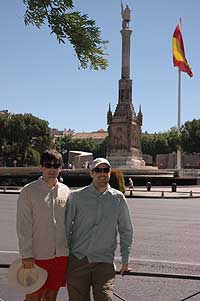

Three hours later we emerged into the late afternoon
heat (34C) and decided to grab some tapas and cerveza in a small plaza before confirming our car
rental for the next day and exploring the Parque del Retiro, a wonderful city park with woods,
rose gardens and a lake for paddle boats. Plaza Santa Ana was our destination for dinner, where
we ate, drank Spanish wine and enjoyed the familial activities in the square.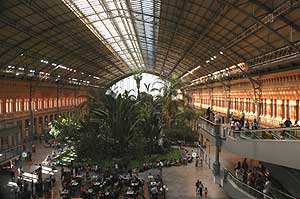
Saturday morning we picked up the car at Estacion de Atocha, the main train station recently renovated with a large indoor tropical garden. The Renault was a compact four-seater with diesel engine. Lauren was the designated driver for the trip, with Ryan and I serving as navigators.
It was surprisingly easy to find our way 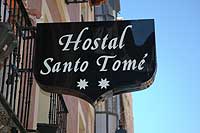 on
a minor highway south across the dry, golden tampa towards Toledo where we had a room waiting
at Hostal San Tome – a small hotel ideally
situated in the centre of the old, historic area with parking nearby.
on
a minor highway south across the dry, golden tampa towards Toledo where we had a room waiting
at Hostal San Tome – a small hotel ideally
situated in the centre of the old, historic area with parking nearby. 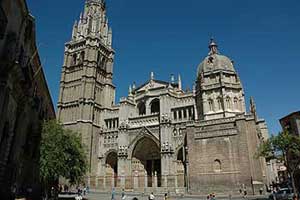
A walled hilltop town considered to be the spiritual heart of Catholic Spain, Toledo has a massive, ornate cathedral – Santa Iglesia Catedral Primada.
With little-to-no vehicle traffic and with most tourists being on a day-trip to Toledo, the town became wonderfully peaceful at dusk and we enjoyed a dinner outdoors with brandy (1866 Gran Reserva) well into the night.
Plans to attend mass at the cathedral on Sunday fell
victim to exhaustion and we rose late, grabbed an espresso and headed south  across
the plains through Ciudad Real to Antequera in the hill region of southern Spain where we spent
the night.
across
the plains through Ciudad Real to Antequera in the hill region of southern Spain where we spent
the night.
Next morning our goal was to get to Ronda, a “white
hill town” which seemed on the map to not be far away. But by car it was a few hours of
winding road before we emerged in the congested town. Being 50km from the sea, many tourists,
staying on the Costa del Sol, take day-trips inland we discovered. 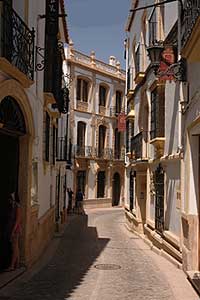
Our first impression of the town was not positive but after a light lunch in the older Muslim part of town, we witnessed the evacuation of the day-trippers and Ronda was transformed into my kind of town.
 With
its very old and still active Plaza De Toros (bull ring,) Ronda is regarded as one of the cradles
of the modern art of bullfighting that emerged during the 18th century. Ernest Hemingway once
wrote: “There is a place in Spain that is the ideal spot to watch a bullfight for the first
time… I am referring to the town of Ronda.” Although there was no bull fight scheduled,
we did tour the ring.
With
its very old and still active Plaza De Toros (bull ring,) Ronda is regarded as one of the cradles
of the modern art of bullfighting that emerged during the 18th century. Ernest Hemingway once
wrote: “There is a place in Spain that is the ideal spot to watch a bullfight for the first
time… I am referring to the town of Ronda.” Although there was no bull fight scheduled,
we did tour the ring.
Ronda sits on two hill-tops, one side, 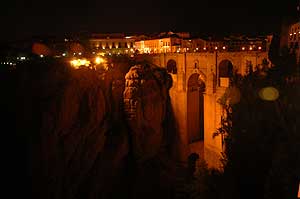 "La
Ciudad", having been Moorish and the other more 'modern', joined by an aqueduct-styled bridge.
That evening we ate in a restaurant clinging to the hillside, and watched the sun set and the
illuminations come on.
"La
Ciudad", having been Moorish and the other more 'modern', joined by an aqueduct-styled bridge.
That evening we ate in a restaurant clinging to the hillside, and watched the sun set and the
illuminations come on.
Additional pictures: Madrid to Ronda
Tuesday morning saw us driving to the coast and enjoying espresso before the teeming crowds littered the beach. Most of the beaches along the south and east of Spain become over-crowded in the summer and have a strong resemblance to the tacky, concrete ones of southern Florida with the high-rise apartments and hotels extending inland from the sea for a mile or two. Hordes of tanned or sunburned tourists funnel each day from them onto the beaches where they jockey for sun and sand.
 By
mid-afternoon we had arrived in Granada and fortune was with us as we found a fine hotel, Hotel
Guadalupe, a few minutes walk from the entrance and ticket booth for the Alhambra, on our
schedule for the next morning. Granada has a delightful historical centre with the Royal Chapel
and crypt for King Ferdinand and Queen Isabel. The evening again found us on another plaza, Plaza
Bib-Rambla, where we ate, drank and watched families and children play simple games in plaza.
By
mid-afternoon we had arrived in Granada and fortune was with us as we found a fine hotel, Hotel
Guadalupe, a few minutes walk from the entrance and ticket booth for the Alhambra, on our
schedule for the next morning. Granada has a delightful historical centre with the Royal Chapel
and crypt for King Ferdinand and Queen Isabel. The evening again found us on another plaza, Plaza
Bib-Rambla, where we ate, drank and watched families and children play simple games in plaza.
Lauren was up at 6 am the next morning to do the 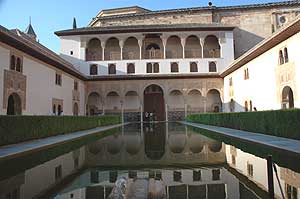 first
stint in the line-up for tickets to Alhambra. Ryan followed him at 7:15 and we were all set to
enter when the gates opened at 8:30. Alhambra controls the number of people that can enter at
any specific time so touring it was pleasant and unrushed. (But personally I enjoyed the plaza
entertainment the night before more than this Moorish palace.)
first
stint in the line-up for tickets to Alhambra. Ryan followed him at 7:15 and we were all set to
enter when the gates opened at 8:30. Alhambra controls the number of people that can enter at
any specific time so touring it was pleasant and unrushed. (But personally I enjoyed the plaza
entertainment the night before more than this Moorish palace.)
By mid afternoon our designated time had expired and
we were off to the coast with the fantasy that we could find a quiet beach with a cozy hotel nearby.
Reality proved us wrong as we drove from one over-crowded beach to another teeming beach. The
coast was far prttier from the vista views as we  drove
across the coastal hills.
drove
across the coastal hills.
By 9 pm, we had arrived tired in Cartagena, a port
city that had been used by the US navy until the end of the cold war. Now rejuvenated and clean,
it was a pleasant stop for the night. 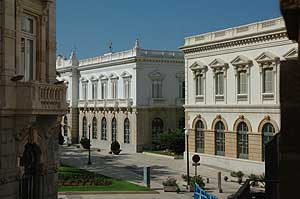
Having had enough beaches, next morning we headed to
Morella, a walled hilltop town up a winding slope southwest of Barcelona. Arriving just after
a Pamplona-style bull-run had taken place down the main street, barriers were still up to guide
the bulls and to protect onlookers.  The
town was alive with excited locals. At first it seemed that every hotel was full but with luck
we found Hotel El Cid within the
walls but quietly away from the bustle. Climbing steps is one of a favourite (and frequent) activity
in hill top towns; it seems that anywhere you want to be is always many steps up or down from
where you happen to be at the time.
The
town was alive with excited locals. At first it seemed that every hotel was full but with luck
we found Hotel El Cid within the
walls but quietly away from the bustle. Climbing steps is one of a favourite (and frequent) activity
in hill top towns; it seems that anywhere you want to be is always many steps up or down from
where you happen to be at the time. 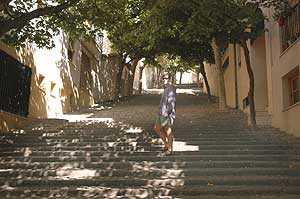
The morning found us climbing 1072 meters up a rocky mountain to the castle El Castillo de Morella, of Muslim origin, overlooking the town and valley.
Additional pictures:Granada to Morella
That afternoon we drove to Barcelona and settled into
a simple hotel, Hostal Central, on Rda Universita, a main avenue near La Rambla. La 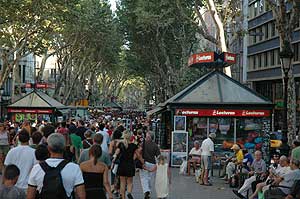 Rambla is a popular, but unpleasantly overcrowded, pedestrian way in the heart of the city. It
has the same type of street entertainers that we find in Victoria and can be found, I suspect,
around the world.
Rambla is a popular, but unpleasantly overcrowded, pedestrian way in the heart of the city. It
has the same type of street entertainers that we find in Victoria and can be found, I suspect,
around the world.
Nearby we found a good restaurant and then listened
to skilled buskers playing classical music on a violin and guitar to the background sound of garbage
trucks chugging past.
Regrettably we had to change hotels the next morning and couldn’t find anything except a small studio in a seedier area to the south near the port. While being guided to it, we came upon a crowd on the street grabbing for free bottle of water. By the time we were past it, my pocket had been picked and I had lost a bill clip with about 100 Euros (fortunately not my wallet with credit cards.)
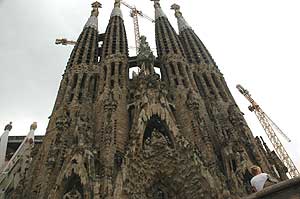 After
regrouping we took the Metro to the Temple
de la Sagrada Familia, a combination of Modernista elements and a unique version of the Gothic
style designed by Antoni Gaudi – quite weird. Started in 1882, it is not yet finished.
After
regrouping we took the Metro to the Temple
de la Sagrada Familia, a combination of Modernista elements and a unique version of the Gothic
style designed by Antoni Gaudi – quite weird. Started in 1882, it is not yet finished.
 Sunday
saw us at Montserrat for 11 am mass. This Benedictine Monk retreat is situated in the serrated
and spectacular mountains of Catalunya where, in 880, a small group of shepherd children reportedly
saw a bright light descending from the sky and heard angels singing and “the music filled
their hearts with a radiant joy.” It is home to the black Madonna (Virgin Mary) in a Holy
Grotto on the mountain. A funicular took us up into the hill with amazing views of the Catalonian
countryside.
Sunday
saw us at Montserrat for 11 am mass. This Benedictine Monk retreat is situated in the serrated
and spectacular mountains of Catalunya where, in 880, a small group of shepherd children reportedly
saw a bright light descending from the sky and heard angels singing and “the music filled
their hearts with a radiant joy.” It is home to the black Madonna (Virgin Mary) in a Holy
Grotto on the mountain. A funicular took us up into the hill with amazing views of the Catalonian
countryside.
Segovia, our destination for the night was 600 km of hard driving away. Arriving late in the evening at our hotel within the walls, Hotel Los Linajes, hungry and tired, we stumbled onto the best restaurant of the whole trip - La Cueva de San Estaban - where we ordered raciones (plates) of suckling pig, cuttlefish, lamb and sautéed peppers (and the usual wine, topped off with brandy.)
Segovia is a gem - a walled town with a magnificent Roman aqueduct, central plaza and gothic cathedral. We should have come sooner and stayed longer.
In the morning, we changed hotel (the first was full) - La Casa Mudejar Hospederia just off of the central square near the Cathedral.
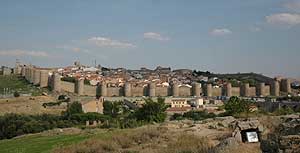 Avila,
60 km away, is described as a beautiful town with intact walls so we made a side trip to it for
the afternoon (the walls are the main/only attraction.) Lauren does not think much of their specialty
dessert, the Yemas. We returned to Segovia to explore the shops and eat at our ‘favourite’
restaurant where we had tipped well the night before so the staff would be happy to see us back.
Avila,
60 km away, is described as a beautiful town with intact walls so we made a side trip to it for
the afternoon (the walls are the main/only attraction.) Lauren does not think much of their specialty
dessert, the Yemas. We returned to Segovia to explore the shops and eat at our ‘favourite’
restaurant where we had tipped well the night before so the staff would be happy to see us back.
The last day saw us returning the car (after driving
3200 km) and walking to Palacio Real
de Madrid. King Juan Carlos resides in a smaller palace outside of Madrid,  and
this palace with 2800 rooms has been turned into a museum although it remains as the Royal Palace
for formal functions. Nearby a cable car ride gave us the chance to cross the valley and view
Madrid from a distance.
and
this palace with 2800 rooms has been turned into a museum although it remains as the Royal Palace
for formal functions. Nearby a cable car ride gave us the chance to cross the valley and view
Madrid from a distance.
The next morning we were up at 4 am to catch a 7 am flight out of Madrid and return to Canada through high security because of recent terrorist arrests
Additional pictures:
Barcelona to Madrid

